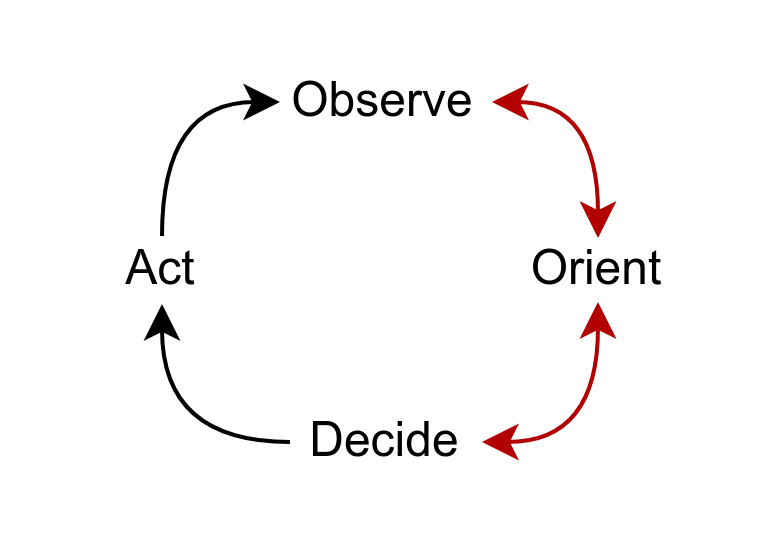(This article is part of an on-going series dedicated to developing Agile mastery. Each post offers value to students on this journey, however, there is an advantage to those who start at the beginning.)
There are many decision strategies and models to choose from - some complicated and resource intensive, such as collaborative or consensus-based techniques, while others can be as simple as flipping a coin. Choosing the the most effective approach is not always an easy task, particularly if there are time constraints. It's a good idea to have a robust set of go-to strategies and models that cover a broad spectrum of situations and conditions.
One that I use frequently is the OODA Loop. Since this is a newsletter devoted to developing advanced levels of understanding and practice, I won't spend much time on what an OODA loop is or it's history. To be brief, it was developed by Air Force Colonel John Boyd, there are four elements to the OODA Loop1:
Observe - If this is the first time through the loop, this is where you identify the issue to be resolved. With subsequent iterations, the task is to observe how the issue has changed in response to any decisions and actions you've made. Observation isn't a passive process. It can involve a great deal of activity, such as gathering and analyzing data and conducting interviews with stakeholders and experts.
Orient - Having collected the information you need (observation), it's time to collate all the pieces and parts and work to assemble the bigger picture. It's a time for reflecting on how all that data and information is interconnected, assess what's important and what's a distraction (signal vs. noise), and determine where there are any gaps in your understanding. If you've already been through the loop before, this is a re-orientation based on changed and additional information from observation.
Decide - There is the process of deciding and then there is a decision. While deciding, time spent on this node is being influenced by what is being learned during observation and orientation. When the course of action with the highest probability of success has been worked out, it's time to act.
Act - Go. While the action is happening, you should already be into the observation phase of the next iteration of the loop.
From it's inception, the OODA Loop was developed to facilitate efficient and rapid decision-making in highly dynamic circumstances - usually involving intense violence and conflict, like jet fighter combat. It's implicitly taught in the martial arts with which I'm experienced - Aikido and Karate - and is applicable across the interactive decision spectrum from physical conflict to emergency response to sports and on into the "civilized battlefield" of business strategy and politics at the other end of the spectrum.
To some extent, everyone goes through some form of the OODA Loop while making decisions in dynamic situations. The problem for most people is the loop is almost always a disorganized mess and never completed. Important information gets missed or mis-evaluated, steps are skipped, and in the end poor decisions are made leading to sometimes disastrous outcomes.
The objective of a continuous process of improving how we use the OODA Loop is to move through our internal process more efficiently such that we **turn inside** the OODA Loop of our adversary. This objective is often what people are describing when they talk about "getting ahead of the curve" or "out in front of a problem." The adversary can be just about anything - a person, a project deadline, a bad habit, etc.
While conflict may have been the context in which it was conceived, I have found the OODA Loop to be effective in highly dynamic situations involving small groups of people as well as with long-term strategic planning. In these situations, the "adversary" is more likely than not the system dynamics of the organization. It's perfectly safe and reasonable to assume everyone in an organization is a well-intentioned professional without a bad bone in their body. They are all nonetheless subject to the crazy mix of cognitive biases and emotions that make us human. That makes the outcome of our behavior somewhat unpredictable. Taken as a whole, the overall system is likely to be your biggest adversary.
The OODA Loop is a strategy that will be familiar to Agilists due to it's iterative nature. (A loop by any other name...) The two week sprint, daily Scrums, Kanban boards, and robust feedback loops are all elements integral to many Agile methodologies that reflect fundamental principles present in the OODA Loop.
The OODA Loop is most commonly represented as:
As I practice it, the loop runs more like:
Within each iteration of the loop, there is an oscillation between the observe and orient nodes driven by what is learned while moving between each of them. Typically, this oscillation can happen multiple times and is very fast. Life get really interesting when you've learned how to nest a few OODA loops within a loop.
Such are the basics for understanding what an OODA Loop is and how it works. Conceptually, pretty easy and straightforward. In practice, the story is quite different. The quality of your OODA Loop-based decisions will depend on your level of skill at each phase. The speed at which you can move through an OODA Loop (or nested loops) will depend on the depth of your experience with the loop.
The steps below will focus on using the OODA Loop with any Agile team, regardless the focus of the project - technical, strategic, marketing, design, talent management, etc. Here's what you need to know...







